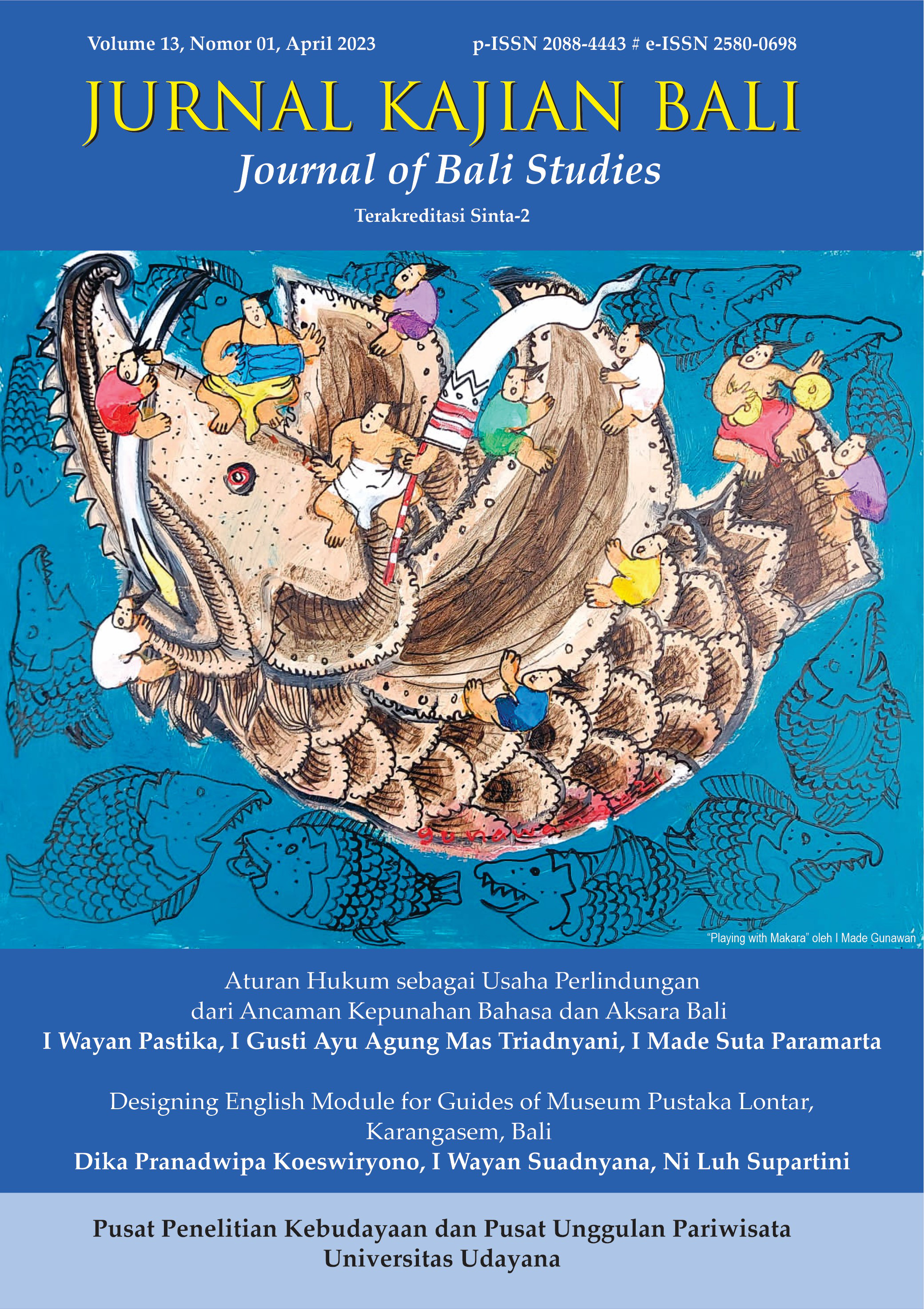From Corpus to Junior Dictionary: An Example of the Balinese Language
Abstract
Corpus has significantly contributed to dictionary-making. However, despite this high potential, scholars need to pay more attention to the benefits of corpus to junior dictionary development of Indonesia’s local language, i.e., the Balinese language. To fill this gap, the researcher built a 56590 word-sized corpus from the data obtained from published Balinese short stories and children’s songs. AntCont version 4.1.1 software was employed to retrieve words and collocations, focusing on selecting nouns for the junior dictionary entries. The study was the first of its kind to utilise corpus to design a junior dictionary for the Balinese language. Theoretically, this study significantly improved the design of a new corpus-based dictionary for junior users that entails unique and culturally bound words in Balinese. Practically, this study expands the number of dictionaries provided as a source for learning Balinese, primarily for junior users.
Downloads
References
Balai Bahasa Provinsi Bali. (2022). Kamus Bahasa Bali - Indonesia. http://kamusbahasaprovinsibali.id/bali-indonesia/cari
Basa Bali Wiki. (2022). Virtual Dictionary of Balinese Language, Culture, Tradition, History, and Arts - BASAbali Wiki. https://dictionary.basabali.org/Main_Page
Beech, J. R. (2004). Using a dictionary: Its influence on children’s reading, spelling, and phonology. Reading Psychology, 25(1), 19–36. https://doi.org/10.1080/02702710490271819
Beratha, N. L. S. (2012). Frasa Bahasa Bali Kuna dan Perkembangannya ke Bahasa Bali Modern. Jurnal Kajian Budaya, 02(02), 69–86.
Bergenholtz, H., & Kaufmann, U. (2017). Terminography and Lexicography. A Critical Survey of Dictionaries from a Single Specialised Field. HERMES - Journal of Language and Communication in Business, 10(18), 91. https://doi.org/10.7146/hjlcb.v10i18.25413
Biber, D. (2011). Corpus linguistics and the study of literature. Scientific Study of Literature, 1(1), 15–23. https://doi.org/10.1075/ssol.1.1.02bib
Collins. (2023). The History of Cobuild - Collins Dictionary Language Blog. Collins. https://blog.collinsdictionary.com/the-history-of-cobuild/
Dash, N. S., & Ramamoorthy, L. (2018). Utility and Application of Language Corpora. Springer. https://doi.org/10.1007/978-981-13-1801-6
de Schryver, G. M. (2010). Revolutionizing Bantu lexicography - A Zulu case study. Lexikos, 20, 161–201. https://doi.org/10.4314/lex.v20i1.62689
de Schryver, G. M., & Prinsloo, D. J. (2000a). Electronic corpora as a basis for the compilation of African-language dictionaries, Part 2: The microstructure. South African Journal of African Languages, 20(4), 310–330. https://doi.org/10.1080/02572117.2000.10587438
de Schryver, G. M., & Prinsloo, D. J. (2000b). Electronic corpora as a basis for the compilation of African-language dictionaries, Part 2: The microstructure. South African Journal of African Languages, 20(4), 310–330. https://doi.org/10.1080/02572117.2000.10587438
de Schryver, G. M., & Prinsloo, D. J. (2012). Electronic corpora as a basis for the compilation of African-language dictionaries, Part 1: The macrostructure. Http://Dx.Doi.Org/10.1080/02572117.2000.10587437, 20(4), 291–309. https://doi.org/10.1080/02572117.2000.10587437
de Schryver, G. M., & Taljard, E. (2007). Compiling a Corpus-based dictionary grammar: An example for Northern Sotho. Lexikos, 17, 37–55. https://doi.org/10.5788/17-0-1163
de Schryver, G.-M., & Prinsloo, D. J. (2003). Compiling a lemma-sign list for a specific target user group: The Junior Dictionary as a case in point. Dictionaries: Journal of the Dictionary Society of North America, 24(1), 28–58. https://doi.org/10.1353/dic.2003.0014
Ethnologue. (2022). Languages of Indonesia | Ethnologue. SIL International. https://www.ethnologue.com/product/19-Report-ID
Hanks, P. (2012). The corpus revolution in lexicography. International Journal of Lexicography, 25(4), 398–436. https://doi.org/10.1093/ijl/ecs026
Johnson, S. (2021). Preface to A Dictionary of the English Language (1755). In Yale University. Yale University Press. https://doi.org/10.12987/9780300258004-038/HTML
KBBI Daring. (2022). Halaman Statistik. Kementerian Pendidikan, Kebudayaan, Riset, Dan Teknologi. https://kbbi.kemdikbud.go.id/Beranda/Statistik
Kementerian Pendidikan dan Kebudayaan Republik Indonesia. (2023). Bahasa dan Peta Bahasa di Indonesia. https://petabahasa.kemdikbud.go.id/
Kilgarriff, A. (1997). Putting frequencies in the dictionary. International Journal of Lexicography, 10(2), 136–155. https://doi.org/10.1093/ijl/10.2.135
Krishnamurthy, R. (2006). Corpus Lexicography. Encyclopedia of Language & Linguistics, 1999, 250–254. https://doi.org/10.1016/B0-08-044854-2/00416-8
Kwary, D. A. (2010). Access routes of internet finance dictionaries: Present solutions and future opportunities. Lexikos, 20, 272–289. https://doi.org/10.4314/lex.v20i1.62715
Kwary, D. A. (2011a). A hybrid method for determining technical vocabulary. System, 39(2), 175–185. https://doi.org/10.1016/j.system.2011.04.003
Kwary, D. A. (2011b). Adaptive hypermedia and user-oriented data for online dictionaries: A case study on an English dictionary of finance for Indonesian students. International Journal of Lexicography, 25(1), 30–49. https://doi.org/10.1093/ijl/ecr008
Kwary, D. A. (2013). Principles for the Design of Business Dictionaries on Mobile Applications. Hermes – Journal of Language and Communication in Business, 50, 69–81.
Kwary, D. A., & Miller, J. (2013). A model for an online Australian English cultural dictionary database. Terminology, 19(2), 258–276. https://doi.org/10.1075/term.19.2.05kwa
Lindquist, H. (2009). Corpus linguistics and the description of English. Corpus Linguistics and the Description of English, 1–219. https://doi.org/10.2478/ICAME-2020-0006
McEnery, T. H., & Hardie, A. (2008). Corpora in Linguistics. 1–312.
Merriam-Webster. (2023). About Us | Merriam-Webster. Merriam-Webster. https://www.merriam-webster.com/about-us/americas-first-dictionary
Merriam-Wesbter. (2023). A Words List for Kids: Browse the Student Dictionary | Merriam-Webster. Merriam-Webster. https://www.merriam-webster.com/browse/kids/
Pastika, I. (2012). Pengaruh Bahasa Asing terhadap Bahasa Indonesia dan Bahasa Daerah: Peluang atau Ancaman? Jurnal Kajian Bali (Journal of Bali Studies), 2(2), 141–164.
Sandro, N. (2008). The Effect of Lexicographical Information Costs on Dictionary Making and Use. Lexikos, 18(0), 170–189. http://lexikos.journals.ac.za/pub/article/view/483/179
Seargeant, P. (2011). Lexicography as a philosophy of language. Language Sciences, 33(1), 1–10. https://doi.org/10.1016/j.langsci.2010.06.002
Segbers, J., & Schroeder, S. (2017). How many words do children know? A corpus-based estimation of children’s total vocabulary size. Language Testing, 34(3), 297–320. https://doi.org/10.1177/0265532216641152
Shadeg, N. A. (2007). Tuttle Balinese-English Dictionary. Tuttle Publishing. https://books.google.com/books/about/Tuttle_Balinese_English_Dictionary.html?hl=id&id=20ktBAAAQBAJ
Suwija, I. N., Darmada, I. M., & Mulyawan, I. N. R. M. (2019). Kumpulan Satua (Dongeng Rakyat Bali) (1st ed.). Pelawa Sari.
Wild, K., Kilgarriff, A., & Tugwell, D. (2013). The Oxford Children’s Corpus: Using a Children’s Corpus in Lexicography. International Journal of Lexicography, 26(2), 190–218. https://doi.org/10.1093/ijl/ecs017

This work is licensed under a Creative Commons Attribution 4.0 International License.



















